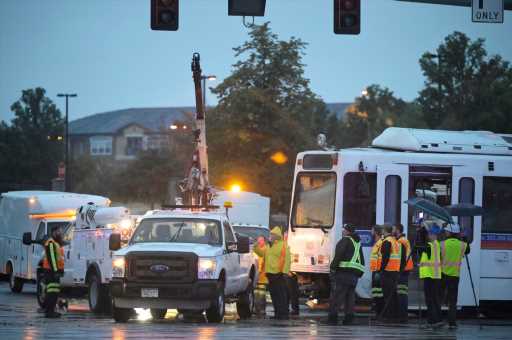A light-rail train that derailed in September was traveling nearly four times the speed limit for a curve in Aurora, according to recently unsealed filings by the Regional Transportation District.
RTD cited the R-Line train’s speed as 38.8 mph as it entered the 90-degree, street-level turn through the intersection of South Sable Boulevard and East Exposition Avenue on Sept. 21. That curve has a posted speed limit of 10 mph.
Three passengers were injured after the train’s two cars decoupled, sending one sliding across the intersection. It was the second derailment at the same location in less than four years.
The R-Line resumed full operations Tuesday, restoring service along a four-mile segment between the Florida and 13th Avenue stations more than two months after the incident.
It had been clear from police surveillance camera footage that the train was going too fast, but the exact speed was disclosed for the first time in RTD’s proposed corrective-action plan, submitted to the Colorado Public Utilities Commission in early November.
The PUC made the plan documents public last week by removing “highly classified” designations from them late on the afternoon of Nov. 23, the day before Thanksgiving.
Earlier this month, initial elements of RTD’s corrective plans received the commission’s blessing, including a lower speed limit along the approach to the curve and a requirement that R-Line train operators come to a full stop before entering the intersection. Both are now in place.
More corrective actions are under discussion. Those include RTD’s proposal to develop, by June 30, “a formal plan for implementation of Automatic Train Stop (ATS)” north of the Sable/Exposition curve. That would involve the installation of a red light signal along the track that would work with existing technology on light-rail trains to trigger an automatic stop if a southbound operator ignores the new operating requirements.
“It does not provide speed enforcement, but will require a stop,” RTD spokeswoman Laurie Huff wrote in an email.
That is much simpler than an earlier plan, made after the first derailment, to explore a widescale speed-control system that would override light-rail trains when they go too fast; a study completed for RTD in January estimated the cost at $91 million to $224 million, depending on the type of system, and no proposal has resulted.
The transit agency has said the operator involved in the derailment “is no longer employed by RTD,” but it hasn’t yet released its investigative report.
The agency’s PUC filings shed some light on the findings. One document cited “inattention by the operator” as he far exceeded the posted track speed. It also noted that the track’s transitions in Aurora — from running in a dedicated right-of-way to running at ground level, through street crossings — contributed to that inattentiveness.
And the agency faulted training and oversight issues, resulting in fresh training sessions for operators this month.
The filings say RTD plans to scrutinize supervisors’ roles as well as train scheduling and the metrics by which operators are judged. The latter two items could unintentionally put pressure on operators to keep R-Line trains moving quickly through Aurora, the corrective-action plan says, even as they must navigate a series of sharp curves that require them to slow down significantly.
Source: Read Full Article
-
Inferno rips through flats in Brit holiday hotspot as people jump from balconies
-
I'm being sued by my neighbours after I tried to get my son's ball back when it went over their fence | The Sun
-
Biden files timeline: How president has tried to downplay the scandal
-
BBC boss: Exodus of older Radio 2 presenters a 'natural evolution'
-
Peter Dillon faces manslaughter charge in 2021 Breckenridge trench collapse

